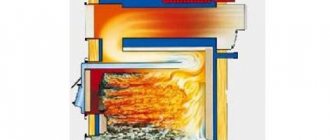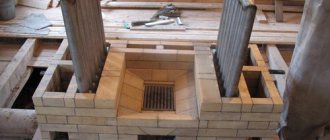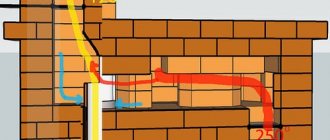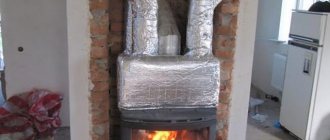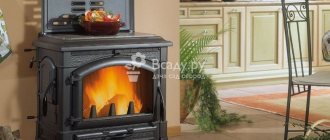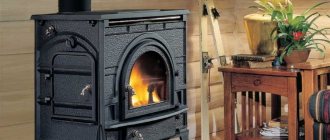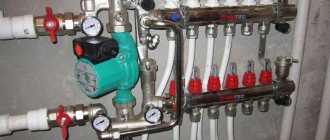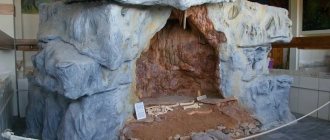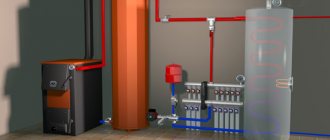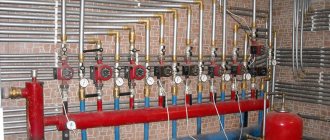Review of various schemes of water heating furnaces
One of the simplest stove designs with a U-shaped heat exchanger installed directly in the firebox. The heater with flat surfaces is made of 4 mm thick sheet metal; it is better to use heat-resistant steel. Another option is a coil in the form of a register, welded from pipes (possibly water and gas pipes) with a nominal diameter of 50 mm and a wall thickness of at least 3.5 mm. The figure shows a diagram of a water-heated furnace of a similar design.
Drawing of a stove with a built-in heat exchanger for water heating
1 – heat exchanger in the combustion chamber; 2 – door for cleaning chimneys; 3 - supply to the heating system.
The principle of operation here is simple: a steel register with a coolant is heated directly from the flame in the firebox, and the combustion products rush upward and make 3 strokes, simultaneously giving off heat to the brick walls and oven for cooking.
A slightly different stove for a home with water heating is a dual-purpose hob with a heater built into the firebox. The stove does not have long chimney channels, since it provides for the extraction of heat from combustion products by a water heat exchanger. The dimensions of the heat source are 1030 x 650 x 780 (height), the heater power is about 9 kW. The latter is made of pipes with diameters of 57 x 3 mm and 48 x 3 mm. The design of the furnace is shown in the photo.
Oven with hob
1 – firebox; 2 – ash chamber; 3 – door for cleaning; 4 – oven; 5 – hob; 6 – clay solution; 7 – water heater; 8 – chimney channel; 9, 10 – respectively, return and supply pipelines of the heating system.
The fuel, when burned, heats the coil directly. Additionally, it is heated by flue gases, which then enter the channel between the hob and oven, go around the latter and are discharged through the chimney. The heated coolant circulates from the register into the system, and the impulse can be either natural or forced. Thus, the water heater removes heat from the firebox and combustion products, cooling them to 150-200 ºС, due to which water heating from the stove is realized.
Despite all the advantages of such a design, there is an irrational grain in its work. The fact is that the combustion products, from which the hob warms up, are strongly cooled by the heat exchanger. It turns out that during cooking it is necessary to reheat the stove in order to warm up the hob, and at this time the water heating of the house will function at full capacity, and this is irrational and uneconomical. To limit the temperature of the coolant, you will have to install a buffer tank - a heat accumulator, otherwise in the autumn-spring period the rooms will become unbearably hot.
The two-chamber wood-burning stove with water heating by K. A. Dmitriev is devoid of the significant drawback described above and is considered the most common option in central Russia. It has separate chimney channels and two separate fireboxes - one for heating the oven and cooking floor, and the second for water heating from the stove. Separate chimneys at a height of 2 m are combined into one. The overall dimensions of the stove are 1500 x 680 x 770 mm (height), the developed thermal power is 9.5 kW, which is already significant, since it is enough for a house with an area of 100-120 m2. The design can be studied in detail using the drawings.
Structural diagram and cross sections of the furnace
1 – ash chamber; 2, 5 – combustion chambers; 3 – oven; 4 – ash pan door; 6 – cooking floor; 7, 8 — connection to water heating; 9 – heat exchanger; 10 – valve.
When the first firebox is operating, flue gases wash around the metal oven and enter the flue located underneath it. The water heater is not involved in the process, so this mode is convenient in the summer and transition period. In the cold season, a second chamber is heated, which is used only to heat a private home and does not affect the operation of the hob and oven. This version of the brick stove is optimal and economical, showing good results in the efficiency of burning solid fuels (efficiency - 50-55%).
Gas generator furnaces
Gas generator furnaces have a number of distinctive features:
- Economical. The stove operates for about 12 hours on one load of fuel.
- Compact sizes.
- High efficiency - about 85%.
- Possibility of adjusting combustion intensity.
- Possibility of using different types of fuel.
- Easy to connect water circuit.
It would seem that the choice in favor of gas generator furnaces is obvious. But before installing such a model, you need to evaluate a number of nuances:
- Essential requirements for the installation of a chimney.
- There is a high probability of condensation forming on the chimney walls.
- Manual adjustment takes some getting used to. Only in this case can all the above benefits be achieved.
- You can use different types of fuel, but there are a number of requirements, non-compliance with which can lead to a deterioration in the quality of heating.
How to build a water stove at home
- There are three ways to do stove heating with a water circuit with your own hands:
- buy a steel stove from a manufacturer whose services include system installation;
- hire a craftsman - a specialist will select the material, make the device, lay out the stove and install the boiler;
- do it yourself.
How to make such a stove yourself
The principle of a boiler for water heating
Can you make such a system yourself? Quite, just experience in welding and bricklaying when building a furnace is enough. First you need to prepare the boiler (register, coil, heat exchanger).
You can buy such a device or make it yourself using sheet iron and pipes. Since the full process of manufacturing and installing a water circuit cannot be summarized in a short review, the main recommendations are presented below.
Manufacturing options and recommendations
Water heating from a wood-burning stove - diagram
For the boiler, a sheet of metal with a thickness of at least 5 mm is used, and its design is made in such a way that there is maximum heating of the water for further circulation. The boiler, welded from sheet steel, is easy to manufacture and operate – it is easy to clean.
But such a heat exchanger has a smaller heating area, unlike a pipe register. It is difficult to make a pipe register at home yourself - you need an accurate calculation and suitable working conditions; usually such boilers are made to order by specialists who themselves install the system on site.
The simplest method of a solid fuel heat exchanger is a regular potbelly stove with a built-in water system. Here you can take a thick pipe as a basis, then there will be much less welding work.
Attention! All welding seams must be made double, since the temperature in the firebox is not lower than 1000 degrees. If you weld ordinary seams, there is a chance that this place will quickly burn out
Complete the register drawings in accordance with the dimensions of the stove at home. The layout of the rooms of the house and the arrangement of furniture also need to be taken into account.
Here you need to pay attention that it is better to choose a scheme with sheet-metal boilers - they do not have pipe bends connected into one continuous circuit. It is not so troublesome to build such a structure
It is also convenient because after installation you can use the hob without any problems, which is not the case with some tube boilers.
Register made of smooth pipes - drawing
When the coolant moves by gravity, you need to raise the expansion tank higher and use larger diameter pipes. If the pipes are of insufficient size, then you cannot do without a pump, since there will not be good circulation.
Boilers equipped with pumps have their pros and cons: you can save money by installing pipes of a smaller diameter and not raising the system so high, but there is one significant disadvantage - when the electricity is turned off or the circulation pump burns out, the heated boiler may simply explode.
It is better to assemble the structure at home, on site, since the device, like individual parts, has a very large weight and dimensions.
System installation
Heat exchanger made of cast iron battery
- Before installation, a solid foundation is poured, on top of which it is better to lay a layer of brick.
- The grate can be laid at different stages: before the boiler, if there is a double structure, the lower part of which can be equal to or higher than the upper part of the grate, when the stove is low and the system is placed a little higher, then the grate, doors, corner on the stove are usually installed after installing the boiler .
- The housing is installed - usually it consists of two containers connected to each other by pipes.
- The entire heat exchange system is welded to the boiler: the exhaust pipe goes to the expander, goes in a circle, through the radiators, and on the other side the return pipe is welded to the boiler from below.
Stove heating with a water circuit allows, firstly, to use firewood much more rationally, and secondly, to evenly distribute warm air throughout the heated room.
If you decide to make your own heating system at home with a water circuit using wood, think through all the stages of the work, and if you have doubts about the successful outcome, it is better to contact specialists.
Water heating device
Closed expansion tank in a stove heating system with a water circuit.
The choice of stove and construction of the entire system is carried out at the stage of planning and construction of the house itself. Most models require the construction of an additional foundation. Heating based on a furnace with a water circuit consists of the following components:
- furnace design;
- heat exchanger (it is located inside or around the firebox, as well as in the form of a coil around the chimney);
- coolant circuits, radiators;
- expansion tank, which is best located in the attic.
In some cases, the heating circuit is equipped with a circulation pump. Installing a heat accumulator will increase the efficiency of the stove.
Water is used as a coolant. To prevent the liquid from freezing, you can add salt to it. Instead of water, you can use glycerin filler.
Pipe selection
It is difficult to control the water temperature in the furnace, so metal pipes are chosen.
Using a furnace with a water circuit for heating a house involves the use of radiators and pipes. Not only cast iron or steel elements are suitable, but also metal-plastic and polypropylene. However, there are some peculiarities here. Since wood is used for heating and there is an open flame, the liquid in the coil may boil. In such conditions, metal-plastic pipes cannot withstand for a long time. It is better to use stainless steel products.
Another reason for choosing metal pipes is that the pipes that come out of the furnace get very hot. Under such conditions, plastic products melt. Pipes that are connected directly to the pipes must have a diameter of 3 cm. For other elements this figure is 2 cm.
Choosing a stove
A universal oven with a hob and a heating circuit.
You can choose a heating device taking into account the technical parameters and purpose of the device. According to the second characteristic, devices are:
- For heating. The generated thermal energy is used only for heating the premises. A heat exchanger tank is installed in this type of furnace.
- For cooking and heating homes. The design of the device provides an additional compartment. An oven is located above the combustion chamber. The heat exchanger can be located on the sides of the firebox. On small stoves there may only be a burner.
The technical characteristics take into account the area of the house, the fuel used and the material of manufacture. The first parameter provides that for every 10 sq.m. The area of the structure requires 1-1.2 kW of energy. At the same time, the ceiling height is 2.5-2.7 m.
Coal, peat, pellets, and firewood are used as fuel. They all have different characteristics: when burning the same volume, different amounts of heat are released. The cost of fuel and its availability are also taken into account.
The following materials are used to make the stove:
- Brick. This option has a lot of weight and dimensions, and therefore requires an additional foundation during arrangement. This design releases heat evenly and for a long time. A specialist is needed to lay a fireplace stove. However, brickwork fits perfectly into any interior, creating a special atmosphere and comfort.
- Cast iron. This material heats up quickly, but is heavy and more brittle than others. It does not require the construction of a separate foundation.
- Steel. The presented option is popular because it is lightweight and durable. The coolant in it heats up faster.
A stove with a heat exchanger does not have the disadvantages of older designs, but it must be selected and installed correctly. Factory models are often equipped with legs that are adjustable. This feature allows you to install the structure even on an uneven base.
Heat exchanger for furnace
Homemade heat exchanger for a brick stove
The heat exchanger is the main element of the stove, so the choice must be approached responsibly. It can be mounted in the firebox, but there is always a risk of coolant leakage. A safe option is to install a heat exchanger in the chimney cap. This element has a different shape and material:
- Made from sheet steel. It can be installed directly into the firebox. The thickness of the material is 3-4 mm. 2 pipes are connected to it. The top one should be connected at the highest point of the exchanger. The internal gap of this element should not be less than 3 cm. In this case, boiling of the coolant can be avoided.
- From pipes. Elements can be round or rectangular. The pipe is also allowed to be installed in the firebox. It all depends on the design of the stove. The main requirement is to install the heat exchanger so that it does not block the door, and the stacking of firewood is free.
- Flat register. This option is often installed in the chimney duct. The heat exchanger can last a long time, since it is not operated in aggressive conditions. It is large in size.
The correct choice of heat exchanger will ensure maximum stove performance.
Principle of operation
Units with a water circuit are equipped with a heat exchanger built into the firebox or chimney duct. There are models that can operate in steam circulation mode.
A wood heating stove can be made of boiler steel or cast iron, designed to operate under high steam pressure. These devices are used both as additional equipment and as the main heat source.
A heat exchanger is installed inside the furnace unit. Heated gases move through the channels of the heating reservoir, transferring heat to the liquid. A furnace with a boiler in its design can have several tanks at the same time, which can significantly increase its efficiency. Water is heated in one tank, and with increased heating, the process of vaporization occurs in the second.
To heat a large building with traditional furnace heating, several furnaces will be required, and the consumption of coal or fuel will be quite high. Therefore, a more economical and alternative option would be a stove for water heating a house using wood, equipped with a special hot water boiler built into the firebox. Even in severe frosts, heating the stove twice a day is enough for such a heating system.
Such devices are capable of heating the building even during breaks between fireboxes. During the cooling process, the pipelines give up their heat for another 5-6 hours, thereby providing heating without consuming fuel. Water heating from a wood-burning stove has an efficiency of 80-85%.
How to make a potbelly stove with a water circuit with your own hands
To heat a garage building without significant material costs, you can use a potbelly stove with a water circuit. It is quite possible to carry out the entire process of installing the system yourself without the help of experienced craftsmen, which will allow you to save money and save the family budget from unjustified expenses.
Making a stove with your own hands requires a person to have some skills in working with metal products and a welding machine. Therefore, we will describe all stages of the work in detail below.
What characteristics should a stove have in a garage?
- Compact sizes. The garage often has a rather limited area in size, so it will not be possible to place a large-sized stove here.
- Economical production and operation. The manufacture and installation of a stove inside a garage should be as affordable as possible, and the stove itself should use fuel economically.
- Variability of fuel type. If you provide for the possibility of firing several different types of fuel, you will be able to optimize the costs of their purchase. For example, in the fall you can heat with pellets, and in the winter with wood.
- Maximum user comfort. It is much easier to achieve this quality if you make the unit yourself.
Required materials and tools
The materials and tools that are relevant for work largely depend on the chosen shape of the stove and the design of the pipes. For heating, a potbelly stove in a garage can be round, square, or rectangular. Round models require the purchase of a pipe or metal barrel with a diameter of 30 cm and a wall thickness of 5 mm.
Also, a potbelly stove is often made from a used gas cylinder. If you want to create a square or rectangular model, you will need sheet metal. To make a chimney, select a pipe with a diameter of 10 cm and a thickness of 1 mm. For a potbelly stove, you can use an old gas cylinder.
In the process of work you need the following tools:
- welding with a minimum current of 200 A;
- set of hammers;
- brush with high-hardness metal rods;
- grinder, the diameter of the circle is 12.5 cm;
- pliers.
Making a potbelly stove
So, you have a large amount of firewood stored for the winter, a wood stove, so it’s a priority. Let's talk about how to make it yourself. Before you begin marking, welding and installing the unit inside the motorhome, you will need to change into a work uniform. This will avoid the risk of burns or abrasions during operation.
Next, perform the following sequence of actions:
Decide on the actual thickness of the walls of the potbelly stove, which will affect the actual thickness of the sheet material relevant for the work. Cut the material according to the drawing, set aside the bottom and walls of the product, numbering the parts on the inside.
Install the bottom at a minimum height from the floor - 30 cm, which will reduce the risk of heating the floor. Then fasten the bottom of the oven to the walls, but not to the front, using a welding machine. Metal legs are also attached to the back of the base of the product.
Important! All structural elements must be connected strictly at right angles and fixed with a welding machine using a T-joint. Three or four holes should be arranged between the firebox and the ash pit to remove ash in 5 cm increments. Below you will need to cut an opening for the ash compartment.
Next, attach the front wall with pre-arranged openings for doors to the structure. At the side of the holes, fix the canopies for fastening the doors of the combustion compartment and the blower. Equip the doors with deadbolts.
Check welds for defects. Next, weld the top side of the stove and the chimney pipe.
Installation of the water circuit
You can implement water heating in the garage using a potbelly stove yourself.
To do this you will need:
- install radiators;
- connect metal-plastic pipes to the stove and radiators;
- install fittings for adjustment in the exit and entrance areas;
- install an expansion tank to protect the pipes from rupture during system operation.
Tips for setting up the system
At their core, such designs are the progenitors of modern solid fuel boilers. But unlike them, heat transfer is carried out not only through piping and a radiator system, but also from the stove itself.
Plus, installing brick stoves with water heating yourself is much easier and cheaper than installing a solid fuel boiler.
A few words about the register
Without exaggeration, the metal register can be considered the heart of the entire heating system. This design is installed directly in the firebox itself and is responsible for the heating level of the coolant.
Lateral arrangement of registers.
The simplest and most affordable option is to install a rectangular metal tank directly into the firebox. Such a tank is made of heat-resistant steel, with a thickness of 3 mm or more, most often from stainless steel.
To heat a house of 200 m², a tank 750 mm long, 500 mm wide and 300 mm high is sufficient. The outlet is made from the top of the structure, the return line cuts into the bottom of the tank.
Registers welded from stainless steel pipes with a wall thickness of at least 3 mm are considered more functional. In this case, the heating area increases several times, hence the efficiency of the system is disproportionately higher.
Advice: it is not difficult to find cast iron registers on the market now; according to most experts, they are the best option. Firstly, cast iron is little susceptible to corrosion, practically does not burn out, and most importantly, this material is considered the best heat accumulator.
Stainless steel registers.
During installation, pay attention to the location of the register. The more contact with fire, the higher the productivity
But at the same time, regardless of the configuration of the tank, there must be a compensation gap of at least 5 mm between it and the walls of the furnace. Otherwise, during heating, the metal will begin to expand and the walls of the firebox will crack.
Diaphragm tank
Installing a register into the firebox is only part of the story; it is equally important to properly arrange the piping. Any heating system built on this principle must be equipped with an expansion or membrane tank
As a rule, it is installed on the return pipe, but this is not important; some craftsmen prefer to mount it at the highest point of the system.
Operating principle of a membrane tank.
In a system with natural coolant circulation, its function is performed by an ordinary metal container. But now, in most cases, owners prefer to install circulation pumps. It is advisable to install a real membrane tank in such a system.
The device is a sealed metal container, in the upper part of which there is a valve. Air is forced through the valve, creating excess pressure in the system. As the temperature rises, the coolant expands proportionally, squeezing the excess into the membrane tank. During the cooling process, the air that presses on the membrane compensates for the pressure drop in the system.
Some aspects of laying a furnace
As mentioned earlier, you can build water-heated brick stoves with your own hands, but if you are not confident in your abilities, it is still better to invite a specialist.
Although in any case, there are general rules that it is not advisable to break.
- All brick ovens are made of solid red brick. It is not advisable to use hollow brick even for cladding. The fact is that hollow blocks are a heat insulator, and in this case this can only do harm.
- If you plan to burn with wood, then the firebox can be made of ordinary baked brick. But if there is a possibility of using coke or high-grade coal, such as anthracite, then we would advise making the firebox from special fireclay bricks, which are used in the construction of blast furnaces.
- There is no need to save on wall thickness; in addition to the weight of the oven itself, the load from the registers will also be added here.
- And yet, any stone structure needs a reliable foundation; as for stoves, the foundation should be laid separately and in no case should it come into contact with the general foundation of the house, the minimum distance between them should be 50 - 100 mm.
Circulation pump in the system.
The video shows some of the intricacies of installing the system.
In this case, we were talking about heating a house. But it is worth noting that if a metal water container is inserted into the system in parallel, it will act as a passive boiler, as a result of which hot water will still appear in the house for domestic needs.
Installation of stoves for a home with a water heating circuit - step-by-step instructions
In order to avoid the unpleasant consequences of improper assembly of the stove and heat exchanger, it is better to involve a specialist installer. He will take into account all the subtleties:
- Fire safety rules. It is necessary to protect the walls around the installation from fire with non-combustible materials.
- Assembling the chimney is the next step. Excellent configuration options can be purchased from the manufacturer Ferrum.
- A special gap of five millimeters, which is left when installing pipes, must be filled with a suitable heat-resistant sealant.
- Under no circumstances should the structure be walled up closely; it is necessary to leave a gap of 10/15 mm between it and the walls to compensate for thermal expansion.
- Afterwards, the equipment is checked and the heating device is installed (the heat exchanger must undergo a strength test with hydraulic or pneumatic pressure of six bar).
- In conclusion, the master connects all components of the structure and checks its readiness.
Operating rules
To ensure continued operation of the heating system, we recommend following the following procedure:
- Do not disconnect the radiator from the device during operation. Water expands when heated, and the increased pressure can cause an explosion.
- If the heat exchanger is already hot, do not allow cold liquid to enter the system, as the temperature difference leads to deformation and damage.
- Do not use an empty heat exchanger to avoid burnout.
- To increase productivity, a circulation pump should be used.
- Use antifreeze if necessary.
- Place the drain valve at the lowest point.
To extend the service life of the heat exchanger, it is recommended to select a unit with a higher power than you calculated according to the existing parameters. This will help reduce the stress that will occur if the furnace is forced to operate at its maximum capacity. This strategy will reduce wear on parts.
To ensure that the heating system functions smoothly, follow the operating instructions.
System Features
A conventional brick stove consists of components such as a combustion chamber, an ash pan, grates and chimneys. These components of a simple Russian stove are probably familiar to any village resident. Visually, modern types of stoves are practically no different from traditional village designs.
Main characteristics of water-heated furnaces
Traditional ovens have the following characteristics:
- A simple village stove can produce more than 6500 Kcal of heat in one hour. This amount of heat is quite enough to heat a house with a small area. Such a heating system would be an ideal solution for a small country house. A water-heated furnace, in which the main component is a water boiler, will be approximately 2.5 times more efficient. Using such a heating system, you can heat a house with a much larger area. In order to heat a house, the same amount of fuel will be required, which means that such a system will be more economical.
- A heating system that combines a stove and a boiler will also be effective. If both systems work simultaneously, their productivity increases many times over. A tandem of two such heating systems can release more than 21,000 Kcal of heat in one hour of operation. This amount of heat is enough to heat a house with an area of up to 300 square meters. meters.
Stove connected to water heating
- Most often, such a heating system uses fuel such as coal or wood. The price of such fuel is not high, and its transportation should not cause any particular difficulties. Firewood can be combined with coal at the same time.
- There is no need to constantly heat water-heated stoves. Fuel can be added to the stove several times a day. You can create comfortable conditions indoors, no matter what the weather or temperature is outside.
- If we compare the efficiency of traditional stove heating with a combined system, this figure will increase from 50% to 85%. For heating with wood, this figure can be called ideal.
- The materials that are necessary to organize such a heating system are quite affordable and are not included in the expensive price category.
Disadvantages of water-heated stoves
Stove heating also has its disadvantages, and it would be unfair not to list them.
A brick stove with water heating can be installed not only in a rural or country house, but also in luxury cottages. Typically, owners of luxury homes strive to ensure that such a water heating stove, in addition to its usual functions, also plays a decorative role. During operation of such a combined system, it is necessary to follow some safety and system care rules:
A stove for water heating at home must be under human control at all times.
This applies not only to the issue of loading fuel, but also to cleaning the ash chamber. Smoke ducts also require attention. Before starting a fire in the lever, you must make sure that the smoke channel valves are in the open position. Such systems can only be used in the cold season
During the warm season, using such a heating stove with a water circuit for cooking will be impractical. If you need to cook food, it is better to use another alternative heat source for this purpose.
If you want to make custom-made stoves for water heating at home, it is better to turn to professionals for help. If your stove is manufactured by an unqualified person, there is no guarantee that the stove will function properly or be completely safe. Overheating of the oven can cause some problems that will eventually lead to complete breakdown of the oven.
A conventional stove is usually designed to heat a small room
Since the flame has high temperatures, it will eventually damage the integrity of the boiler walls. This means that the time will come when the heat exchanger will need to be replaced. This is not so easy to do, since you need to remove a good part of the masonry.
Advantages and disadvantages
The stove has become a necessary item in the Russian cold weather, but is often associated only as a heating method. However, stove heating with a water circuit can provide both heat and hot water.
Pros:
- high service life even under extreme conditions;
- the use of environmentally friendly materials for the firebox, which are freely available and at an affordable price;
- variety of designs;
- multifunctionality - makes it possible to heat the room, cook, reheat food;
- the similarity of appearance with a fireplace increases the level of comfort.
However, there are a number of disadvantages that await the owner during operation:
- long warm-up until heat transfer;
- you need to carefully look after the ash pan, chimney, draft;
- the greater the power, the larger the size of the heating device;
- increased fire hazard;
- the heat will be distributed only to those rooms that are in the immediate vicinity of the installation;
- most of the heat escapes through the pipe, which significantly reduces the efficiency indicator;
- you will have to lay firewood in a timely manner, clean the stove from waste and ash;
- to install the unit, you need to have certain knowledge;
- If the device is used incorrectly, it may cause carbon monoxide poisoning.
When people are not permanently in a residential complex, but come for the summer, it is recommended to use a frost-resistant substance for the stove that can withstand thawing and freezing without destroying the structure, in order to preserve its primary functions.
Integrating a stove into an existing heating system
If you already have a heating system that has previously been used with a different type of heating, you can connect a furnace to it. For example, it can become a replacement for a gas boiler.
Modern heating equipment usually does not contain a heating tank. But, it has a heat exchanger that performs a similar function.
The cost depends on a lot of factors - material, size, efficiency, maximum permissible heated area, etc. Moreover, there are models that allow not only to heat the house, but also to provide a full-fledged hot water supply system.
Factory stoves usually allow the use of both classic wood and coal, and pellets, which is a compressed wood material used as fuel.
Instructions for building a stove heating system with a water circuit
- A hole is being dug.
- A “cushion” is laid, consisting of broken bricks, crushed stone and medium-sized rubble. The width of this layer is approximately 20 cm. Natural materials are compacted and filled with cement mortar.
- Bricks are being laid. It is laid in two rows on cement, and covered on top with a waterproofing layer of roofing felt, parchment and roofing felt.
- A brick foundation is being built with clay mortar.
- The first continuous row is laid. In the second row, an ash chamber begins to form, for which a special door is installed. The third row repeats the previous one.
- The fourth row is formed. It serves as the basis for the fuel chamber made of refractory bricks; grooves are provided on it for installing the grate.
- A U-shaped boiler made of steel is installed. Two pipes are welded to it - one at the top for supply, the other at the bottom for return. It also has a rectangular hole through which heated gases will escape.
- The fifth row is laid. It is necessary to provide channels behind the side and rear walls of the boiler. Two small doors are installed on them to remove soot.
- A sixth row is formed, in which a hole is provided between the gaps made in the previous row. This is a suction channel to increase draft in a heating furnace. The door for the fuel chamber is also installed here.
- The wall is being laid out. It should be taken into account that fire-resistant bricks are laid around the door leading into the combustion chamber and above the fuel boiler.
- Cast iron stoves are being installed on which food can be cooked. A metal corner is attached to the entrance of the heating and cooking chamber.
- Chambers are formed, a channel is made on the back surface, and doors are installed.
- The facade of the cooking chamber in the 16th row is covered with a metal strip. And then it itself is covered by laying bricks on specially laid metal strips.
- A steam exhaust valve is installed to ventilate the furnace and an upper flue is formed.
- 35 rows are laid, on which the construction of the chimney begins.
Some people want to use a ready-made stove or fireplace, combining it with a water circuit. In this case, you will have to disassemble them almost to the ground in order to install the register.
Mayevsky crane
Methods for installing a combined heating system
There are three main ways to organize a combined heating system:
- With the construction of a new furnace. The need to build a new heating device makes it possible to choose the most suitable furnace model and heat exchanger, as well as to develop a competent scheme for the main project.
Diagram: device of a heating furnace with a water circuit
- Installing a heat exchanger in a finished furnace. This option is the most difficult to implement. First of all, this is due to the need to correctly calculate the dimensions according to which to make the coil. After this, you will have to disassemble part of the furnace, install the register and, if the draft was normal, reassemble everything in the same order. You can do this yourself if you have some experience as a stove maker or at least a mason.
- Installation of a factory furnace with a ready connection to the water circuit. Fireplaces, potbelly stoves and stoves with an installed water circuit have long been available for sale. All that remains is to create a closed system, connect pipes, radiators and the necessary equipment.
How the system works
The simplest water circuit is with natural circulation of water flow. Its basis is a simple physical phenomenon: the expansion of liquids when they are heated. The unit that creates pressure is an expansion tank (a container for collecting water), installed in the attic or attic.
The water circuit is a closed system. The boiler heats the water in it and, expanding, it is directed through a pipe into a storage tank. The movement is carried out under pressure created by the cooled water constantly entering the boiler and passing through the entire system. Boiling water from the expansion tank is directed by gravity down through the pipes leading to the batteries. Having given off the heat, it returns to the tank and heats up again.
Installing a pump will help to significantly increase the pressure in the system and speed up the circulation of the coolant. At average outdoor temperatures, it can be turned off and the circuit will function on the natural movement of water. This will save you on your energy bills. Water enters the pump with the check valve closed. By turning it off (leaving it open), the entire volume of coolant is directed to bypass the pump.
Such a stove can be loaded not only with wood or coal. When using alternative fuels, it is possible to complicate the structure of the system by adding:
- granule storage tank;
- a mechanism that feeds pallets into the firebox (pneumatic or auger).
You can make the operation of the furnace easier by installing an automatic system for regulating its operation and forced ventilation.
Masonry and brick
Stove maker is a profession that has been known since ancient times. Masters of masonry have always enjoyed special respect among all categories of the population. A qualified craftsman will create a unit such as a Russian water-heated stove, which will always have an evenly heated surface and excellent traction.
There are several main rules that must be followed by all specialists in this field:
- The combustion chamber must be made only from materials that are distinguished by their fire-resistant properties. If the fire escapes from the hearth, it can damage even ordinary brick or stone.
- When laying the walls of the stove, there is no need to skimp on materials. If the walls are laid with a quarter of a brick, this can significantly reduce the reliability of the entire structure.
- The tightness of the seams also requires special attention. If you leave even a small gap, carbon monoxide can then escape through it, and this can be very dangerous to human health.
Brick stoves with water heating today are modern equipment that will effectively heat your home.
https://youtube.com/watch?v=CZiTLx_zq5c
Brick oven
The configuration of an old stove is not very suitable for combining it with water jackets, tanks, pipes, and other elements of water heating. This requires special drawings and diagrams.
In addition, it is necessary to lay a foundation under a brick oven and provide conditions for proper traction. These jobs require the craftsman to have good masonry skills and engineering knowledge. Otherwise, you risk being poisoned by combustion products (carbon monoxide) or simply collapsing the house.
Read here - How to choose a solid fuel boiler for heating a private home
Positive and negative aspects of stove heating in a private house
In most cases, stove heating is installed if necessary, in the absence of main natural gas. But heating with a stove has its advantages and disadvantages, which it would also be nice to know about.
What are the disadvantages?
Negative points include:
- It takes quite a long time to heat up the stove, and therefore the premises. This occurs due to prolonged heating of the walls and coolant in the system.
- Not very high efficiency of a brick building. To increase it, you have to build a higher chimney, make it a labyrinth type, so that the heat remains inside the structure longer.
- A brick stove occupies a fairly large area, but only on such a scale is it capable of heating several rooms at the same time.
- Unlike heating with natural gas, the stove must be supervised throughout its entire combustion, since brick options require constant addition of fuel. Long-burning cast iron stoves are an exception, since firewood is added once per burning session.
Positive points
Stove heating also has many positive qualities, which are often decisive in choosing it for installation in a private home.
How to make it yourself
The stove in a private house must be connected to a chimney.
To heat the house in the winter cold, you can build a heating system yourself. To make a stove with a heat exchanger for heating, you need to follow the following order:
- Making a stove from sheet material. The prepared elements are welded together at an angle of 90 degrees. The exception is the front wall. The bottom of the device should be located at least 20 cm from the floor.
- The space between the firebox and the ash pit is separated by a grate.
- Preparing the canopies and installing the door.
- Chimney installation. It is installed at the top of the structure.
- Preparing a container for liquid and fixing it.
After connecting the device to the system, it should be checked for defects. The stove must be designed and operated in compliance with safety regulations.
A stove with a water heat exchanger is the best option for small residential buildings. It allows you to save money on space heating. The main advantage of the system is the possibility of its independent production.
Installing a coil on a pipe
This is an excellent and fairly simple way to increase the efficiency of the stove. Flue gases heat the pipe to extremely high temperatures. The outer coil, like the inner one, helps reduce the temperature and somewhat cool the outer surfaces of the chimney. An external water heat exchanger is especially often installed on metal chimneys. This is an excellent auxiliary device for heating small spaces.
This heat exchanger has two pipes. The top one is connected to a pipe going to the storage tank, the bottom one is connected to the heating circuit. It is easy to make such a structure, as well as attach it to a pipe.
Exploitation
The potbelly stove is used taking into account some features:
- The smoke exhaust duct must be led outside - through the ceiling or wall. It is prohibited to connect the pipe to ventilation. Intersection areas must be reliably insulated using non-combustible materials.
- Modern designs of metal stoves, when properly assembled, can efficiently heat one room with an area of up to 30 square meters. But the garage must be well insulated.
- If the heating area is more than 30 m2, the organization of a circuit is mandatory.
- When there is a potbelly stove with a circuit in the room, you should always have a box of sand and a container of water ready.
- It is necessary to arrange a separate place for storing firewood for the stove, since their consumption will be rather large.
- Compliance with all operating and fire safety regulations will keep the property safe and sound.
Rules of care
The stove will serve for a long time, provided that the owners follow the rules for caring for the equipment. These include:
- Open the condensate container daily to drain the water. It is placed on the chimney.
- Before starting the heating season, the chimney is thoroughly cleaned of soot that has settled and stagnated in it using special tools.
- During operation, the stove body and pipe are regularly inspected to prevent exhaust smoke from entering the garage.
- It is important to constantly monitor the condition of the hood and supply ventilation.
Recommendations for caring for the structure
Self-construction of a metal wood-burning stove is not only effective. With the right approach, such a stove becomes a real decoration of the room. But the main thing is to follow all the rules of construction, care and operation.
Preparation and selection of installation site
To begin, lay out all the materials in front of you. But we do this at the place where the stove is installed. We choose the latter like this. For maximum efficiency, the heat generator is mounted in the corner of the room so that the heat spreads across 2 walls and is not lost in 4 directions.
In this case, it is necessary to leave a small gap from the walls, equal to approximately 150 mm. If the stove is used in a country house, it is advisable to provide a chimney during its construction and run the upper section of the pipe through the roof.
There is no need to lay a foundation for our unit, because with the given parameters the weight will be small. If the stove is planned to be massive, then it is better to prepare a concrete base.

